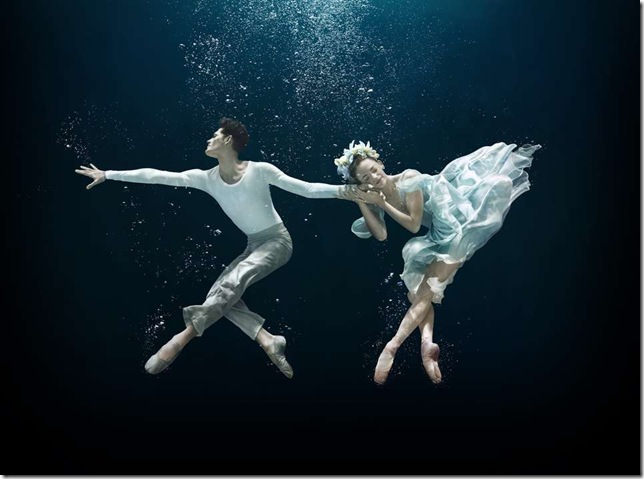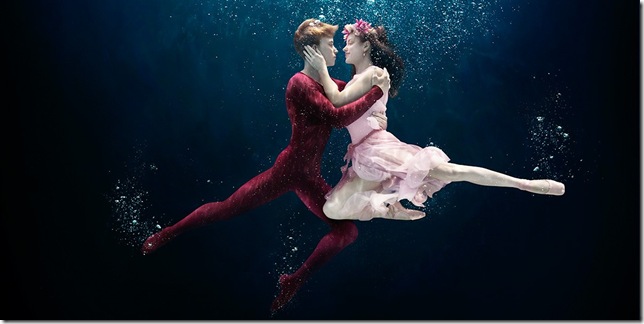Renan Cerdeiro and Emily Bromberg in A Midsummer Night’s Dream. (Photo by Alberto Oviedo)
By Tara Mitton Catao
The closing program of Miami City Ballet’s 30th anniversary season was a stunning new production of George Balanchine’s A Midsummer Night’s Dream — and what a sumptuous event it was.
On Saturday night at the Kravis Center, there was a palpable sense of anticipation through-out the packed house. Maybe this began when it was announced that the $ 2.1 million project would be a “reimagining” of the first evening-length ballet that George Balanchine had fully choreographed himself.
But without a doubt, the mesmerizing underwater publicity photos by Alberto Oviedo were responsible for a great part of the allure of the program. Each photograph was a thing of grace and beauty. They heralded that this production was going to be something special and not just a “redoing”.
Visual artist Michele Oka Doner was the costume and set designer and playwright/director/actor Tarell Alvin McCraney was in charge of dramaturgy. The involvement of these two very different and highly recognized Miami artists was part of Artistic Director Lourdes Lopez’s continuing interest in collaborating with the artistic community of Miami City Ballet’s hometown.
Add the momentum of knowing that the production included an enormous cast of dancers performing together with dozens of students and children from the company’s school, choral singers and the many musicians of the Opus One Orchestra (under the stellar leadership of conductor Gary Sheldon), and it was natural that the interest in this new take on Balanchine’s version of William Shakespeare’s comedy set to the music of Felix Mendelssohn was very high.
It wasn’t long after the curtain rose that we took a sensational dive into another world. We entered a magical domain under the surface of the waterways of Miami where Oka Doner’s visuals of extravagant underwater plant life came alive, undulating in the current.
With the help of Paul Vershbow’s projections viewed on multiple scrims, the result was startlingly effective as if the dancers were captured in a large hologram. The challenge of lighting the space within as well as highlighting the moving dancers without diminishing the impact of the constantly changing projections and the general murkiness of the underwater mood was well met by company lighting designer John Hall.
The set, lights and costumes had created such a strong visual impact that it was good to see that MCB dancers could hold their own. All the performers looked confident and technically strong not only in their dancing but also in their acting. Throughout the production, there was a cohesion in the acting that was much more refined than I have seen in other works the company has performed.
Balanchine’s fast-moving and trim version of the complicated storyline kept this whimsical tale moving along even though the thought kept resurfacing in my mind: how can these characters breathe underwater?
Chase Swatosh and Jennifer Lauren in A Midsummer Night’s Dream. (Photo by Alberto Oviedo)
Nevertheless, the mix of the traditional characters with the new sea creatures, shimmering in their array of fanciful costumes in their underwater world, gave a brand-new look to Act I.
In her role as Titania, the rebellious Queen of the Fairies, Simone Messmer had a bold lushness. Her languid upper body was accented by her quick and beautiful feet and legs. Kleber Rebello showed a regal strength in his beautifully pliant jumps and beats in his role as Oberon, the controlling King of the Fairies.
Shimon Ito was a delightful Puck who showed equal finesse and ease in his soaring and pristine jumps while he caused romantic havoc with his sprinkling of magic love dust. Jennifer Lauren and Chase Swatosh were the contented lovers while Emily Bromberg was discontented in her constant pursuit of Renan Cerdeiro, who pined after another.
Didier Bramaz convincingly danced the part of Bottom who, in this Florida-focused production, was transformed not into a donkey but into a manatee. Unfortunately, this transformation looked a little silly with the manatee head looking more like a decapitated child’s stuffed toy. Despite this, Messmer was beautiful (as she danced under the spell that Oberon had put on her) showing tenderness and love towards Bramaz.
Natalia Arja was well-suited for the part of the darting lead butterfly with her high and sharp jetés. Yet again logic surfaced: a butterfly underwater? I had to remind myself that this was, after all, just a dream.
The technologically heightened visuals of Act I did reach a Disney moment when images of four large air bubbles suddenly appeared to four strong musical cues and floated upwards to the surface.
Act II was the celebration of the impending wedding of Hippolyta, Queen of the Amazons (Jordan-Elizabeth Long) and Theseus, Duke of Athens (Carlos Miguel Guerra). The events took place at the Coral Castle (an eccentric construction in Miami) and the festivities opened with the Courtiers — the ladies of the court dressed in sublime white appliquéd tutus with lavender tulle under-layers and the men is matching lavender tunics and white tights — dancing to Mendelssohn’s famous “Wedding March.”
Somewhere along the way of being lavishly regaled with pageantry and patterns, I regretted being fished out of the magic of the deep waters. I was now at a wedding (as is so often seen in the final acts of a full-length ballet) but this time, it was done with splendid pomp and circumstance by Balanchine.
The real jewel in Act II was Shakespeare’s “play within a play” that Balanchine replicated with a “ballet within a ballet.” Portraying idealized romantic love, this lovely pas de deux was beautifully performed by Jeanette Delgado and Renato Penteado.
Delgado, whom we haven’t seen at all this season, was absolutely radiant in her interpretation of this exquisite divertissement. Penteado’s assured partnering of Delgado seemed effortless but incredibly sensitive in the tricky choreography. With the many complicated changes of grip and reversals of the promenades of Delgado’s lingering arabesques, Penteado always showed great care and attention as he adeptly sensed the delicate balances that perfectly suited Delgado’s flow of movement.
A Midsummer’s Night’s Dream was a dream of a production. Without logic or even a real storyline, its tumble of choreographic and technological images were visually intoxicating. The abruptness of the complete contrast between Act I and Act II still existed but each act was so well done, did it really matter?
Miami City Ballet has taken an important Balanchine work and rebooted it. Let’s hope that it will appeal to the technological generation and that more young people will come to the theater and get their feet wet with this wonderful production of a very beautiful art form.
A Midsummer Night’s Dream can be seen at 8 p.m. Saturday and 2 p.m. Sunday at the Broward Center for the Performing Arts in Fort Lauderdale. Tickets start at $20. Call 954-462-0222 or visit www.browardcenter.org.

